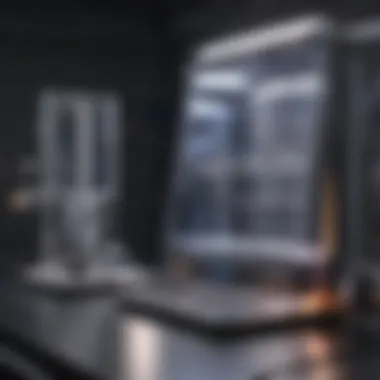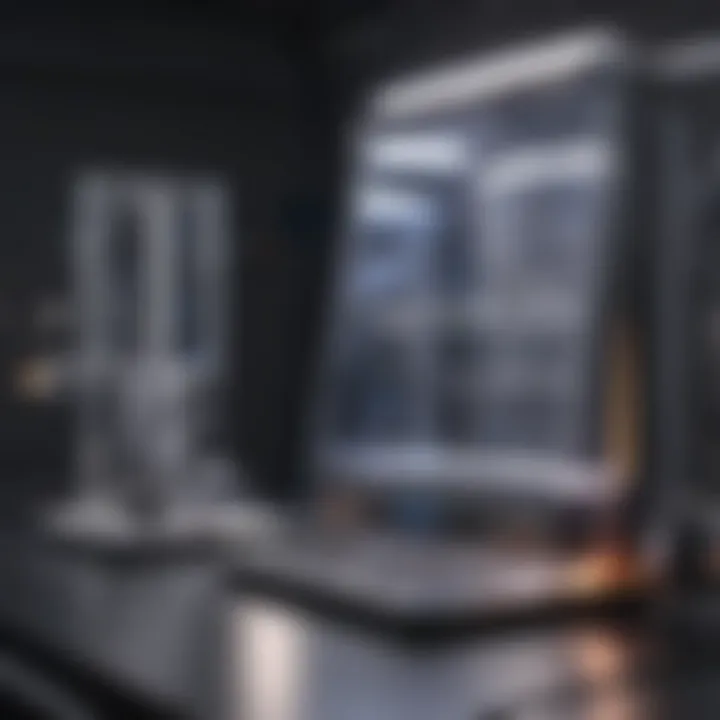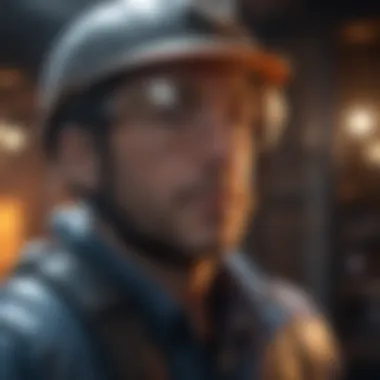Can Ultraviolet Light Effectively Eliminate Germs?


Intro
Ultraviolet (UV) light has garnered significant attention as a potential solution for germicidal applications. The ongoing global challenges posed by pathogens underscore the urgency for effective disinfection methods. The unique properties of UV light make it a promising candidate in the fight against many harmful microorganisms.
As we explore the nuances of UV light and its germicidal efficacy, we will examine its scientific fundamentals, explore the various technologies harnessed for disinfection, and discuss practical applications across different domains. The aim is to provide readers with an insightful perspective on how UV light can contribute to public health initiatives and the mitigation of germ-related risks.
Research Highlights
Overview of Key Findings
Extensive studies reveal that UV light, particularly the UV-C spectrum, can effectively inactivate a wide range of microorganisms, including bacteria, viruses, and fungi. The mechanism behind this effectiveness lies in the ability of UV light to damage the nucleic acids of these pathogens, hindering their replication and resulting in their inactivation.
- UV-C light has a wavelength range from 200 to 280 nanometers, which is most effective for germicidal purposes.
- Research indicates that exposure to UV-C light for a certain duration can eliminate over 99% of pathogens on surfaces.
- The efficiency of UV light disinfection may depend on several factors, including intensity, distance from the source, and duration of exposure.
Significance of the Research
The research surrounding UV light's germicidal properties is crucial for several reasons. In settings such as hospitals, public transportation, and food processing facilities, effective disinfection methods are essential for controlling infection. Moreover, the rise of antibiotic-resistant pathogens makes UV disinfection a viable alternative.
Understanding the efficacy of UV light contributes to improved public health policies and safer environments. This research also paves the way for technological innovations in UV disinfection, providing practical solutions to mitigate outbreaks and enhance sanitation measures in daily life.
"The rise of antibiotic-resistant pathogens necessitates innovative approaches to infection control, making UV disinfection increasingly relevant in modern healthcare and public health contexts."
Applications of UV Light
UV light has found diverse applications across various sectors. Notable areas include:
- Healthcare: Sterilization of surgical instruments, patient rooms, and air purification systems.
- Food Safety: Sanitizing food processing equipment and extending the shelf life of perishable goods.
- Water Treatment: Effective in disinfecting drinking water and wastewater management.
- Household Use: UV lamps for disinfecting surfaces and reducing allergens in homes.
Each application takes into account the specific needs and sensitivity of employed techniques. Safety measures regarding human exposure to UV light are also paramount, as improper use can cause skin and eye damage.
Technological Advancements
Recent developments in UV technology are noteworthy. Innovations include portable UV devices, integrated systems in air conditioning units, and even UV robots that autonomously disinfect spaces. These technologies enhance convenience while ensuring more effective sanitization.
- LED UV Technology: Compact and energy-efficient solutions that deliver targeted UV wavelengths.
- Automated Disinfection Systems: Smart systems that monitor and optimize disinfection processes in real-time.
These advancements reflect an increasing recognition of UV light's potential in improving sanitation protocols, particularly in often-overlooked spaces.
Finale
Overall, the exploration of ultraviolet light as a germicidal agent reveals significant promise. Its capacity to inactivate harmful pathogens is critical in numerous applications. By combining research insights with emerging technologies, UV light can play a vital role in safeguarding public health against infectious diseases.
Prolusion to Ultraviolet Light
The exploration of ultraviolet light’s potential in germicidal applications is becoming increasingly significant. Understanding ultraviolet light is essential because it plays a critical role in disinfection processes across various sectors, including healthcare, water treatment, and public spaces. The natural ability of UV light to inactivate harmful microorganisms is particularly relevant in today's world, where there is a growing emphasis on hygiene and infection control.
UV light is a part of the electromagnetic spectrum, situated between visible light and X-rays. This positioning allows it to possess sufficient energy to impact biological systems, primarily through damaging the DNA of microorganisms. As we delve deeper into this topic, we will discover not just its capabilities but also the historical context of its discovery and applications.
Furthermore, knowing the science behind ultraviolet light provides insight into its safe and effective use. As we discuss, various wavelengths of UV light present unique advantages and challenges, making this knowledge critical for its application in technological advancements in disinfection methods.
In essence, the understanding of ultraviolet light sets the foundation for appreciating its efficacy and relevance in public health initiatives and technological applications.
Defining Ultraviolet Light
Ultraviolet light, commonly referred to as UV light, encompasses electromagnetic radiation with wavelengths shorter than visible light. Specifically, it ranges from about 10 nanometers to 400 nanometers. There are three primary types of UV light: UVA, UVB, and UVC, differing primarily in their wavelengths and biological effects. UVA ranges from 320 to 400 nm and penetrates the skin deeply, whereas UVB has shorter wavelengths (280 to 320 nm) and is primarily responsible for sunburns. UVC, on the other hand, spans from 100 to 280 nm and is the most effective at germicidal action, as it can destroy the DNA of bacteria and viruses.
Understanding these distinctions is crucial, especially considering that UVC light is primarily used in disinfection applications, while UVA and UVB have other functions in skincare and health.
History of Ultraviolet Light Research
The journey of ultraviolet light research began in the early 19th century. In 1801, Johann Wilhelm Ritter first identified UV light while experimenting with sunlight. He noticed a chemical reaction in silver chloride, a phenomenon that was stronger in the invisible spectrum beyond violet light. Since then, advances in technology have refined the understanding of UV radiation.
By the early 20th century, scientists began to recognize the germicidal properties of UV light. The introduction of UVC lamps in the 1920s marked a significant milestone, enabling hospitals and laboratories to use UV light for sterilization. Over the years, research has expanded, illuminating various applications—from water purification processes to air and surface disinfection methods.
Today, as we grapple with challenges posed by infectious diseases, ongoing research into UV light's effectiveness continues to pave the way for innovative disinfection technologies. This history not only highlights the evolving recognition of UV light's potential but also emphasizes its growing importance in modern public health strategies.
Mechanism of Action
Understanding the mechanism of action for ultraviolet light is essential for grasping how this technology works in germicidal applications. The actions UV light takes on pathogens can be both complex and fascinating. By breaking down its effects on microorganisms, we can appreciate its potential in disinfection. The focus here will be on how UV light interacts with these harmful agents, ultimately neutralizing them. This knowledge assists in assessing different scenarios where UV technology might be effectively utilized in public health.


How UV Light Affects Microorganisms
DNA Damage Mechanism
One significant aspect of the DNA damage mechanism is how ultraviolet light interacts with the genetic material of microorganisms. When UV light penetrates microorganisms, it causes alterations, primarily in the DNA structure. This alteration often leads to thymine dimers, which are connections between adjacent thymine bases that disrupt normal DNA replication. The result can impede a microorganism's ability to reproduce, leading to its death.
What makes the DNA damage mechanism particularly compelling is its high efficiency. It selectively targets the DNA of germs, reducing the likelihood that they can develop resistant strains. However, it is worth noting that while effective, the effectiveness can vary based on factors like the intensity of the UV light and the duration of exposure. It is effective mainly for surface disinfections.
Cell Death Pathways
In addition to direct DNA damage, UV light can trigger distinct cell death pathways in microorganisms. When the DNA is damaged, it may signal various cellular pathways that lead to apoptosis or programmed cell death. This cellular response is instrumental in efficiently eliminating the threat posed by pathogens.
The key characteristic of this pathway is its potential to induce a rapid response in microorganisms. They detect damage and either initiate repair mechanisms or divert into cell death processes. This rapid response is beneficial in controlling infections. However, not all microbial cells respond predictably to such mechanisms, which illustrates a potential disadvantage. The variability leaves room for some microorganisms to survive under specific conditions.
Types of Ultraviolet Light
Different classifications of UV light interact uniquely with microorganisms. Each type operates at specific wavelengths and brings varying levels of germicidal effectiveness. It is critical to discern between these types to understand their application in disinfection processes.
UVA
UVA light, measured mainly at wavelengths between 320 to 400 nm, tends to penetrate the skin more deeply than other types. Although its germicidal effectiveness is somewhat limited compared to UVB and UVC, it can contribute to the breakdown of certain biological materials. The characteristic long wavelength allows for adverse effects on microbial cells over a longer time.
However, it should be noted that using UVA for sterilization is generally not optimal. Its germicidal capabilities require prolonged exposure times, which can be impractical for many applications.
UVB
UVB light operates between 280 and 320 nm and is more effective at causing direct DNA damage in microorganisms compared to UVA. Its primary role in disinfection arises from the ability to induce more aggressive mutations in DNA. This characteristic makes UVB a popular choice for applications like water treatment and certain disinfection protocols.
One limitation of UVB is its relatively shorter penetration depth compared to UVA. Therefore, its effectiveness decreases significantly for thick or turbid materials, restricting its practical uses in certain environments.
UVC
UVC light, which occurs in the range of 100 to 280 nm, stands out as the most powerful germicidal type of ultraviolet light. UVC works by effectively destroying the DNA and RNA of microorganisms, thereby incapacitating their ability to reproduce. The focus of many disinfection technologies is on this type of UV light due to its efficacy.
What makes UVC particularly advantageous is its ability to work quickly and effectively, requiring comparatively shorter exposure times. One drawback is that UVC radiation is harmful to humans, necessitating careful handling and safety precautions in its use. Despite this, UVC remains a first choice for effective disinfection in various applications, from air purification systems to water treatment designs.
Applications of UV Disinfection
The utilization of ultraviolet (UV) light in disinfection is a critical area of focus due to its broad spectrum efficacy against numerous pathogens. The applications of UV disinfection span various domains, playing an essential role in public health. It becomes increasingly important to understand how UV can be effectively employed in different contexts: water treatment, air purification, and surface disinfection. Each application demonstrates unique benefits, but they all share a common outcome — the reduction or elimination of harmful microorganisms.
Water Treatment
UV disinfection has established itself as a vital technology in the realm of water treatment. This method involves exposing water to UV light, effectively destroying bacteria, viruses, and other pathogens without the use of harsh chemicals. One of the key advantages is that it does not affect the water’s taste or odor, unlike chemical treatments which may introduce unwanted residues.
The effectiveness of UV disinfection in water treatment relies on several factors:
- Intensity of UV Light: Higher intensity leads to better germicidal effects.
- Exposure Time: Sufficient time must be maintained for pathogens to be in contact with the UV light.
- Water Clarity: Turbidity can hinder the effectiveness, as sediments can shield microorganisms from UV rays.
Overall, UV disinfection systems contribute significantly to drinking water safety, reducing the risk of waterborne illness, making them an increasingly popular choice in municipal and residential settings alike.
Air Purification
In our ever-evolving understanding of pathogens, air purification has emerged as a critical application for UV technology. UV light can significantly reduce airborne microorganisms, thus improving indoor air quality. Various systems employ UV light, often integrated with existing HVAC systems to enhance the disinfection of circulated air.
The advantages of UV air purification include:
- Reduction of Allergens: By eliminating mold spores and dust mites, it creates a healthier environment.
- Continuous Operation: Systems can work tirelessly, providing ongoing protection without extensive upkeep.
- Chemical-Free Solution: It avoids potential harmful effects associated with chemical air fresheners or disinfectants.
However, to maximize the effectiveness of UV air purification systems, regular maintenance and monitoring are essential, ensuring that the UV lamps are functioning at optimal levels.
Surface Disinfection
Surface disinfection is another crucial application where UV light demonstrates robust capabilities. Especially in situations where bacteria and viruses can survive on surfaces for extended periods, UV disinfection offers an efficient solution.
Common settings for UV surface disinfection include:
- Healthcare Facilities: Hospitals utilize UV systems to disinfect high-touch areas and minimize Hospital-Acquired Infections (HAIs).
- Food Industry: Restaurants and food processing plants implement UV disinfection to ensure surfaces are free from harmful microorganisms.
- Public Spaces: Especially after the COVID-19 pandemic, many public areas have adopted UV technologies to enhance sanitation protocols.
Advantages of using UV for surface disinfection are:


- Time Efficiency: Quick disinfection cycles when properly calibrated.
- Effectiveness Against Resistant Strains: UV light can target pathogens that are resistant to traditional chemical disinfectants.
Efficacy of UV Light Against Germs
The efficacy of ultraviolet (UV) light in killing germs is crucial to understanding its role in public health. Several studies demonstrate its capacity to successfully eliminate a variety of pathogens. The relevance of UV light lies not only in its efficiency but also in its application across different sectors such as healthcare, water treatment, and surface disinfection. These points deserve careful examination.
Factors Influencing Effectiveness
Exposure Time
Exposure time refers to the duration for which microorganisms are exposed to UV light. This factor directly influences the outcome of disinfection. Longer exposure often results in more effective germicidal action. However, the required duration depends on various parameters, including the intensity of light and type of pathogen present. This characteristic makes exposure time a flexible option in various disinfection scenarios.
One unique feature of exposure time is that it can be adjusted based on the context. For instance, in environments where pathogens are highly resistant, longer exposures may be necessary. Conversely, in less demanding situations, shorter exposure can suffice. Both approaches have their advantages and drawbacks.
Intensity of UV Light
When discussing intensity, we must consider the power output of UV devices. The intensity of UV light is vital for effective germicidal action. Higher intensity can lead to quicker disinfection. This is important in settings such as hospitals, where rapid turnover is essential.
However, intense UV light can also pose safety risks to humans if proper precautions are not taken. This duality highlights the importance of finding a balance in intensity for safe and effective disinfecting. An advantage of high-intensity UV systems is their efficiency, especially in large spaces. Yet, one must also tread carefully, as increased intensity without oversight can lead to harmful exposure.
Type of Pathogen
The type of pathogen targeted significantly influences the overall effectiveness of UV disinfection. Different microorganisms exhibit varied susceptibilities to UV light. For example, bacterial spores may require a different UV dose compared to viruses or fungi. Recognizing the specific characteristics of each type is essential for optimizing UV germicidal practices.
This aspect of pathogen susceptibility makes it a beneficial topic of discussion. For instance, while UV light is effective against many pathogens, certain strains may show enhanced resistance. This resistance can complicate UV disinfection efforts. Hence, understanding the specific characteristics of pathogens can lead to more informed decisions on UV applications.
Comparison with Other Disinfection Methods
Chemical Disinfectants
Chemical disinfectants, such as bleach or alcohol, are commonly used in several settings. They effectively kill a wide range of pathogens. One key characteristic of these chemicals is their ability to work quickly and over a range of organic materials. This is why many opt for chemicals over UV in situations requiring immediate germicidal action.
However, chemical disinfectants also present drawbacks. Prolonged use can lead to chemical buildup and resistance in certain pathogens. Moreover, they often require rinsing or ventilation to mitigate toxic residues. These considerations make a comparison between UV light and chemical methods essential, as one can weigh their respective efficiencies and safety issues.
Heat Treatment
Heat treatment is another widely utilized method for disinfection. It employs high temperatures to kill pathogens effectively. One of the key characteristics of heat treatment is its ability to penetrate materials like food and textiles. This makes it a popular choice in areas like food safety and textile sanitation.
Despite its advantages, heat treatment has limitations too. It may not be suitable for all items, particularly those that can be damaged by high temperatures. In this article, the contrast between heat and UV light in disinfecting various surfaces creates a comprehensive understanding of these techniques. It helps users recognize which method serves their purpose better under certain conditions.
In summary, the effectiveness of UV light against germs is contingent upon multiple factors, including exposure time, intensity, and the type of pathogen. Thus, analyzing these elements gives deeper insight into the application and importance of UV disinfection in infection control.
Safety Considerations
Safety considerations are a critical aspect when discussing ultraviolet (UV) light and its germicidal properties. While UV light can effectively kill pathogens, it also poses health risks if not used properly. Understanding these risks helps to ensure safe use in various applications, thus maximizing its benefits in infection control. This section will highlight the potential health effects of UV exposure, necessary precautions, and guidelines to maintain a balance between effectiveness and safety.
Health Risks of UV Exposure
Skin Effects
UV light can cause various skin effects, which are essential to address. The primary concern is overexposure leading to skin burns and long-term consequences, such as skin cancer. The key characteristic of skin effects is that they occur with direct exposure to UV radiation, particularly from UVB rays. This information makes it vital for individuals using UV devices to be aware of the skin's sensitivity to these wavelengths.
Potential skin damage includes redness, blistering, and even peeling in severe cases. The unique feature of skin effects lies in their cumulative nature; repeated exposure can lead to more serious conditions over time. Understanding these dangers will help users implement protective measures actively.
Eye Damage
Eye damage is another significant health risk associated with UV light exposure. The main concern here is photokeratitis, often described as a "sunburn of the eye." This condition results in pain, redness, and in some cases, temporary vision loss. The key characteristic of eye damage is that it can happen quickly, compared to skin effects, sometimes even after just a few minutes of exposure.
This information highlights the necessity for protective eyewear when operating UV devices. The unique consideration for eye damage is the potential for long-term harm, such as cataracts, making it essential to use safeguards.
Safety Precautions in UV Applications
Protective Gear
Using protective gear is crucial in UV applications to mitigate health risks. The most common forms of protective gear include specialized suits, safety goggles, and gloves. The primary characteristic of protective gear is its ability to block harmful UV rays, preventing direct contact with the skin and eyes. This makes it a vital choice in environments where UV disinfection occurs.
However, a limitation is that not all protective materials are equally effective against all types of UV radiation. Choosing suitable protective gear allows users to safely perform UV disinfection tasks without unnecessary stress over potential health impacts.
Operational Guidelines


Operational guidelines also play a significant role in ensuring safety when using UV light in disinfection. These guidelines often outline procedures for safely operating UV devices, including setting up areas free of unnecessary personnel and ensuring proper ventilation. The key characteristic of operational guidelines is their structured approach, allowing users to minimize risks effectively.
Inadequate adherence to guidelines could lead to accidents, compromised safety, and wasted resources. Understanding operational guidelines enables informed decision-making, fostering a culture of safety around UV disinfection practices.
Effective use of UV light not only requires knowledge of its benefits but also a firm understanding of safety practices.
In summary, safety considerations are essential in harnessing UV light’s germicidal potential. By understanding the health risks of UV exposure and implementing appropriate precautions, users can enjoy the benefits of UV disinfection while minimizing potential adverse effects.
Technological Advances
Innovations in ultraviolet light (UV) disinfection technology mark significant improvements in the fight against pathogens. As public health concerns grow, these advancements represent not merely technological progress but also enhanced capacities for infection control across various environments.
Innovations in UV Disinfection Technology
Portable UV Devices
Portable UV devices have emerged as convenient solutions for numerous disinfection needs. These compact devices provide flexibility and accessibility, making them beneficial for both commercial and residential usage. A key characteristic of portable UV devices is their ease of use; users can quickly deploy them in various locations, ensuring that hard-to-reach areas are disinfected effectively.
One unique feature of these devices is their battery-operated functionality. This allows for operation in settings without access to electrical outlets, increasing their utility. Despite their many advantages, one disadvantage is the limited coverage area. Larger spaces may require multiple devices or longer application times to ensure thorough disinfection.
Automated UV Systems
Automated UV systems represent a leap forward in ensuring consistent and efficient disinfection. These systems are typically integrated into existing infrastructure such as HVAC systems or used in dedicated disinfection chambers. The key characteristic of automated UV systems is their ability to operate with minimal human intervention, enhancing safety and efficiency.
A unique feature of automated systems is programmability. Users can set schedules and protocols, allowing for routine disinfection without manual operation. This feature is beneficial in high-traffic areas, such as hospitals and airports, where regular disinfection is paramount. However, there are disadvantages; the initial investment and setup can be substantial, which may not be feasible for all facilities.
Future Trends in UV Research
Research into UV disinfection technology continues to evolve. Future trends may focus on improving the efficiency and effectiveness of existing methods. There might also be an emphasis on developing UV devices that minimize energy consumption while maximizing output. Moreover, ongoing research into the impact of UV light on various pathogens will likely refine application protocols and expand the technology's usability in diverse settings.
> The evolution of UV technology brings hope for more effective infection control in health settings and public spaces.
In summary, technological advances in UV disinfection highlight the adaptability of these systems to meet modern health challenges. Both portable and automated devices offer unique benefits and considerations, shaping the future of germicidal applications.
Public Health Implications
The topic of ultraviolet (UV) light as a germicidal agent holds significant relevance in public health. Its ability to inactivate a wide range of pathogens makes it a critical tool in infection control strategies. Primarily, UV disinfection contributes to reducing the transmission of diseases, particularly in health care settings, public transport, and community spaces. As health organizations seek cost-effective and efficient methods to maintain hygiene, UV technology offers a reliable option that can supplement traditional disinfection methods.
The benefits of utilizing UV light for infection control are manifold. First, it operates without the use of harsh chemicals, thus minimizing environmental impacts and chemical exposure for both patients and healthcare workers. Second, UV systems can be employed in continuous environments such as hospitals or schools to maintain a higher standard of cleanliness without disrupting daily activities.
Moreover, as antibiotic resistance continues to rise, alternative methods like UV disinfection are increasingly required. By effectively reducing bacteria, viruses, and fungi in various settings, UV light plays an essential role in the global strategy against infectious diseases. This correlation between UV application and public health safety underscores the necessity for wider education and implementation.
"Ultraviolet light can enhance and support existing disinfection protocols, creating a multi-barrier approach to infection control."
Role in Infection Control
Infection control is paramount in safeguarding public health, and UV light serves as a formidable ally. As pathogens become resistant to conventional disinfectants, the efficacy of UV light presents a promising avenue for controlling infections. With the capacity to disrupt the DNA of microorganisms, UV light prevents replication, ultimately leading to cell death. This direct action not only helps in managing established infections but also plays a preventive role in reducing the risk of outbreaks.
Key sectors where UV light proves invaluable include:
- Healthcare Facilities: Hospitals use UV disinfection to sanitize operating rooms, patient rooms, and equipment.
- Public Spaces: Libraries, transit systems, and schools can utilize UV to mitigate the spread of common illnesses, such as the flu.
- Food Treatment: In food processing industries, UV light assists in reducing the microbial load on surfaces and contaminants.
The integration of UV technology into existing protocols ensures a layered defense against pathogens, which is essential for effective infection control strategies.
Case Studies and Success Stories
Numerous case studies highlight the successful application of UV disinfection in various contexts. For instance, a hospital in Toronto implemented UV technology in its intensive care unit and observed a significant decrease in healthcare-associated infections. The results indicated a 30% reduction in infection rates among patients who were treated with UV-cleaned equipment compared to those who were not.
Another example comes from a public transportation system in San Francisco. They adopted UV lamps for nightly disinfection of buses and trains. Following this measure, reported influenza cases among commuters dropped substantially, signifying the efficacy of UV light in curbing contagion in crowded settings.
These success stories underscore the noticeable impact of UV disinfection in improving public health outcomes. By providing evidence of effectiveness, they can foster greater acceptance and implementation of UV technologies across various platforms. As more organizations recognize the power of UV light in fighting germs, the potential for broader health benefits becomes imminent.
Epilogue
The conclusion of this article serves to encapsulate the critical findings about ultraviolet light's role in disinfecting and controlling pathogen populations. UV light is recognized as an effective and powerful disinfectant. Understanding its mechanism can influence how we apply it in various settings, from hospitals to water treatment facilities.
Summary of Key Points
- UV Light Mechanism: Ultraviolet light damages the DNA of microorganisms, preventing their replication and leading to cell death.
- Types of UV Light: UVC is the most effective at germicidal applications, while UVA and UVB have limited effectiveness against pathogens.
- Applications: UV disinfection is utilized in water treatment, air purification, and surface sanitation, showcasing its versatility.
- Effectiveness Factors: The degree of UV's disinfection ability is influenced by factors such as intensity, exposure time, and the type of pathogen.
- Health Considerations: Adequate safety measures must be in place to prevent harmful exposure to UV radiation.
- Technical Innovations: Ongoing advances in UV technology promise more efficient methods of germicidal applications.
Future of Ultraviolet Disinfection
The future of ultraviolet disinfection appears promising. As public health concerns escalate, the demand for effective disinfection technologies rises. This will likely drive further research and development in the field. Innovations such as portable UV devices and automated systems may become commonplace in both residential and commercial settings.
- Increased Applications: Beyond traditional uses, novel applications might arise in industries such as food processing or pharmaceutical manufacturing.
- Regulatory Considerations: As technologies develop, guidelines and regulations will need updating to ensure safety and efficacy standards are met.
- Integration of AI: Artificial intelligence could be integrated into UV systems for precise monitoring and control, enhancing overall effectiveness in real-time.
In summary, the continued exploration and application of ultraviolet light in germicidal contexts are crucial for public health management and in the fight against infectious diseases. The possibilities are vast, and with the right investments and research, ultraviolet disinfection can become an essential tool in our hygiene arsenal.







